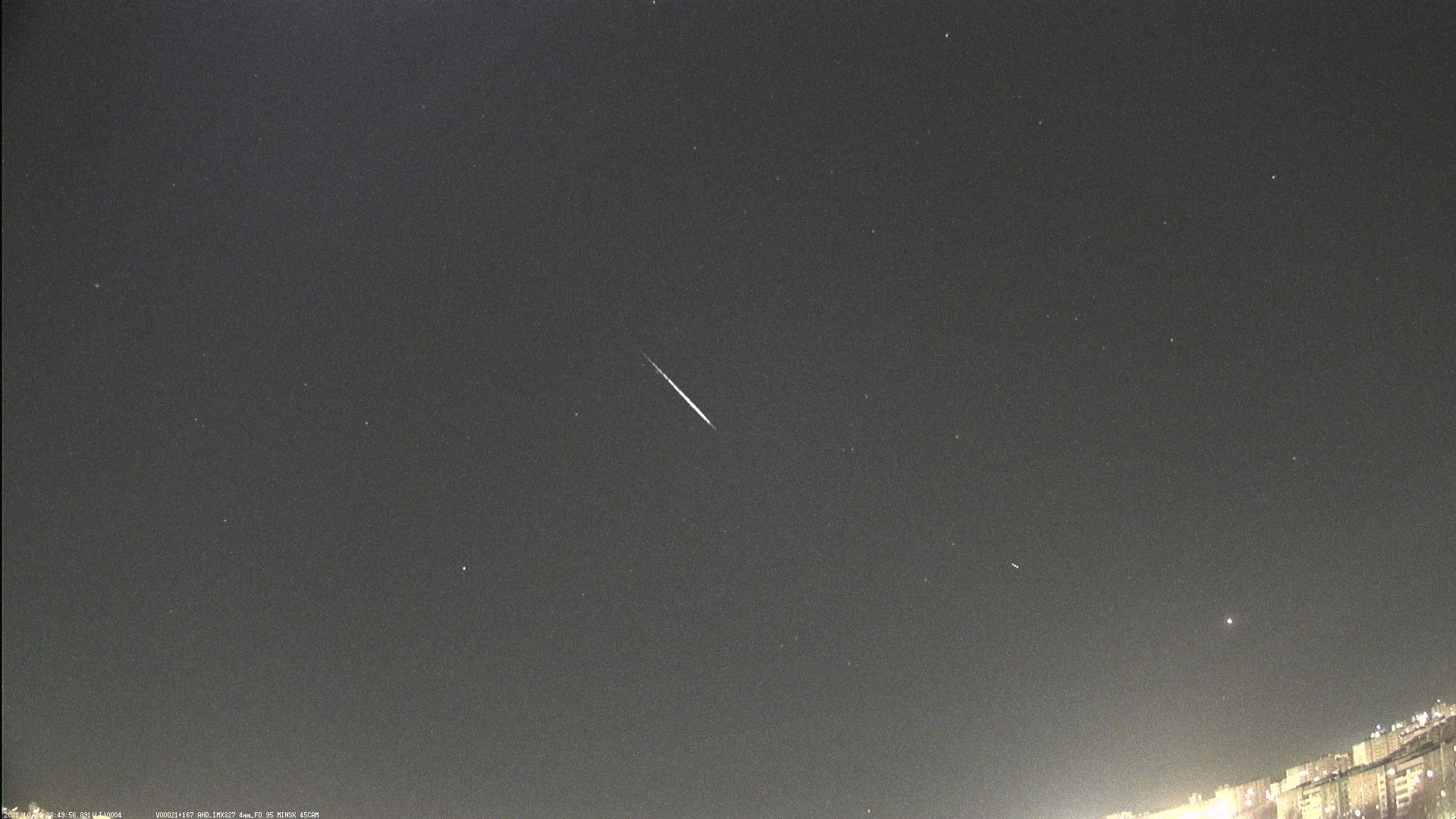Abstract: The October zeta Perseids (OZP#01131) meteor shower was discovered during the night of October 24–25, 2021 by the Global Meteor Network. That night, the Belarusian meteor video network also recorded 3 additional orbits from this new shower during the short activity interval on 2021 October 24.
Introduction
The end of October is a time when clear skies in Belarus are very rare. However, on the night of 24–25 October 2021 the sky was completely clear, which can be considered as a great luck. The Belarusian meteor video network recorded 218 multi-station meteors that night. Analysis of the data shows that among them three meteors belong to the new October zeta Perseids meteor shower.
Chronology of registration of the October zeta Perseids
The first meteor was captured October 24, at 20h41m37s UTC by three cameras at the camera stations in Minsk, Derazhnoye and Grodno (Figure 1).
The second meteor was also captured by three cameras at the camera stations in Minsk, Derazhnoye and Zaslavl about 8 minutes after the first one October 24, at 20h49m56s UTC (Figure 2).
The third meteor was captured about 1hour and 12minutes after the second one, October 24, at 22h02m15s UTC by two cameras in Derazhnoye and Grodno (Figure 3).

Figure 1 – First meteor captured on October 24, 2021 at 20h41m37s UTC. Recorded at Derazhnoye, Belarus.

Figure 2 – Second meteor captured on October 24, 2021 at 20h49m56s UTC. Recorded at Minsk, Belarus.

Figure 3 – Third meteor on October 24, 2021 at 22h02m15s UTC. Recorded at Derazhnoye, Belarus.
The trajectories of meteors belonged to the October zeta Perseids and the camera positions on the ground map are shown in Figure 4.

Figure 4 – Trajectories of the multi-station October zeta Perseids plotted on the ground map.
Orbital elements
An analysis of the data shows that all 3 meteors coincide well within the October zeta Perseids radiant, the coordinates of which have been added into Meteor Data Center catalog (Vida et al., 2021; Roggemans et al., 2021).

Figure 5 – Radiant positions of three multi-station October zeta Perseids plotted on a star map.
The radiant coordinates for the multi-station meteors and their orbital elements were calculated with UFOOrbit. The quality of the orbits for meteors #1 and #2 is good, it corresponds to Q2 quality in UFOOrbit. The orbit of meteor #3 has Q1 quality. The data obtained are listed in Table 1 below.
Table 1 – Three October zeta Perseids meteors recorded 2021 October 24 by the Belarusian meteor video network.
| 20:41:37 UTC #1 | 20:49:56 UTC #2 | 22:02:15 UTC #3 | |
| λʘ (°) | 211.3585 | 211.3642 | 211.4143 |
| αg (°) | 58.315 | 57.021 | 57.269 |
| δg (°) | +34.025 | +32.963 | +34.275 |
| Hb (km) | 107.3 | 106.2 | 98.2 |
| He (km) | 87.7 | 88.6 | 87.9 |
| vg (km/s) | 47.7 | 47.5 | 45.5 |
| mA | –1.0 | –1.8 | –0.9 |
| a (AU) | 18.2 | 73.0 | 5.9 |
| q (AU) | 0.085 | 0.082 | 0.095 |
| e | 0.9954 | 0.9989 | 0.9839 |
| ω (°) | 326.489 | 326.655 | 325.417 |
| Ω (°) | 211.358 | 211.364 | 211.414 |
| i (°) | 64.5 | 59.0 | 57.2 |

Figure 6 – The orbits of the October zeta Perseids, top view on the ecliptic.
Conclusion
As previously reported by Denis Vida, October zeta Perseid activity was observed on October 24, 2021 from 19h10m UTC to 22h13m UTC, with the main peak occurring between 20h30m–21h00m UTC. The first two meteors (20h41m UTC and 20h49m UTC), detected by the Belarusian meteor video network, occur exactly at the time near the maximum peak. The 3rd meteor (22h02m UTC) appears much later, near the end of the observed shower activity.
Thus, the timing of 3 detected meteors falls within the activity interval indicated by other observers. The radiant positions as well as the orbital elements are in perfect agreement with previously published data. This means that we were lucky enough to catch these amazing meteors, belonging to the recently discovered long-period October zeta Perseid meteor shower.
Acknowledgment
Many thanks to all participants in the Belarusian meteor video network for their efforts: Andrei Prokopovich, Igor Balyuk, Konstantin Morozov and Sergei Dubrovski.
Special thanks to Paul Roggemans for his help with writing the article.


